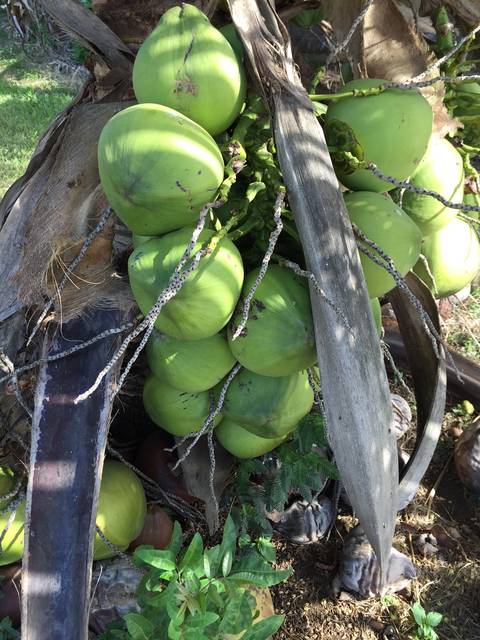When the first humans arrived in Hawaii, edible nutritional kernals or nuts were hard to find. About the only native nut was the mahoe, or Alectron macrococculus. They brought with them the coconut and the kukui nut. Technically, the coconut
When the first humans arrived in Hawaii, edible nutritional kernals or nuts were hard to find. About the only native nut was the mahoe, or Alectron macrococculus. They brought with them the coconut and the kukui nut. Technically, the coconut is not a true nut and although kukui nut is edible, it can create serious stomach issues when eaten. So in the arena of foods and nutrition, true nuts were lacking.
In the mid-20th century, University of Hawaii researchers scoured the tropical world for nut crops that might adapt to some of Hawaii’s diverse climates. Many nut-bearing species, like almonds and cashews, were introduced but none really found popularity like the Australian macadamia nut. Researchers developed many superior varieties and it wasn’t long before farmers began growing them commercially. Today, when folks think macadamia, they think Hawaii since the best varieties were promoted as Hawaiian macadamia even though they are now grown in parts of Africa, America and Australia, as well.
Be sure to mark your calendar on Sunday, Nov. 12, to celebrate our delicious Hawaiian macadamia nuts. The Going Nuts for the Holidays Festival will be held 10 a.m.-5 p.m. at Hale Halawai in Kailua-Kona. Info: Visit www.hawaiianwellness.com
In the meantime, let’s visit some of the other nuts with potential here.
Cashews fit well in the home garden. The nut or seed develops at the bottom of the cashew fruit. It is easily grown from seed and becomes a small, round-headed tree. Cashew trees are related to mango trees and have irritating sap, so the seed must be handled carefully when processing. The juicy fruit is edible.
At elevations above 4,000 feet, pistachios and almonds may possibly be grown, but are not readily available at local nurseries. They may be specially ordered from California, however. Growing conditions that are cool and dry are best.
Getting back to the coconut palm, it makes a great tree for the Hawaiian garden. The dwarf Samoan form is the best and available at some local nurseries. The tree will start producing fruit when young and may be easily harvested at near ground level for years.
When was the last time you had pili nut pie or pili nut brittle, or pili nut cookies? Unless you have lived in the Philippines, it is probably never. How about tropical almond cookies? Again, we don’t see them here, but tropical almond confections are popular in Haiti and other parts of the Caribbean. The tropical almond, false kamani, or Terminalia catappa, is originally from the East Indies but is now found all over coastal regions of the tropical Pacific.
The Philippine islands are a fascinating and beautiful part of the world. They are rich in plant and animal life and populated by many interesting indigenous people with diverse cultures.
We are fortunate here in Hawaii to have a large Filipino population that has brought a lot of flavor to our multicultural mix. It is surprising that more of the fruits and nuts that are popular there are not mainstream here. For example, one of the tastiest nuts found in Manila is the pili. The pili nut, Canarium ovatum, is native to the Philippines and is the most important of about 10 nut-bearing species. The tree reaches an ultimate height of about 60 feet. Leaves are compound like the African tulip. Flowers are yellow, fragrant and form in terminal clusters. Male and female flowers are borne on separate trees, so two trees of opposite sexes are required to produce nuts on the female tree. The oblong greenish fruits are black when ripe and are almost 2.5-3 inches long. The nut can be eaten raw or roasted, and some consider it superior to the almond. My favorite recipe is the same as making peanut brittle, substituting pili nuts for peanuts.
In the Philippines, the kernel is made into several products, including plain roasted nuts, sugar coated nuts, pudding and pili nut butter. They are great in nut chocolates and are a source of good cooking oil. The shell is an excellent source of fuel and is also used as a planting medium. In Indonesia, the shells are also made into ornaments. Resin may be tapped from the tree as with the rubber tree. It is used in perfumes, adhesives, plastics, printing inks, paint, varnish and many other products.
The University of Hawaii Waiakea Experiment Station has been studying pili production for years and found it to grow very well in the Hilo region. It is a beautiful tropical tree. At this time, it appears the best growing areas would be below 1,300 feet, protected from strong winds and given irrigation where annual rainfall is below 50 inches.
The limiting factor in growing pili trees is the availability of plants. Most trees in Hawaii and the Philippines are grown from seed. Grafting, and budding are difficult. Air layering has limited success. Since the university does have a number of trees, it would be possible to obtain seed by contacting a UH College of Tropical Agriculture and Human Resources extension office. Seed are not always available, but may be obtained when ready. The university also has information on orchard establishment. Although pili nut could be grown in a standard orchard layout, it also lends itself to growing under natural forest conditions as is done in the Philippines. Since significant yields do not occur until the 10th year, inter-cropping is desirable. This can fit in well with multi-crop, sustainable agriculture systems.



